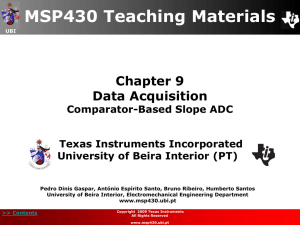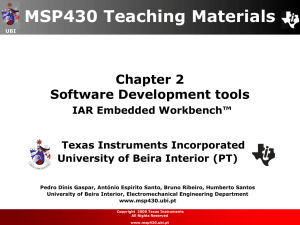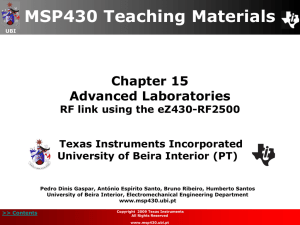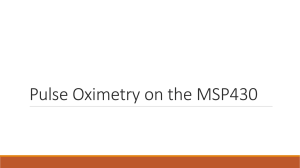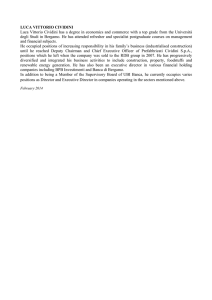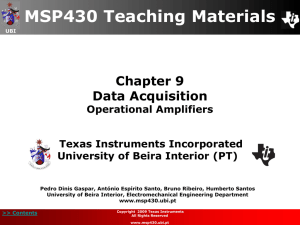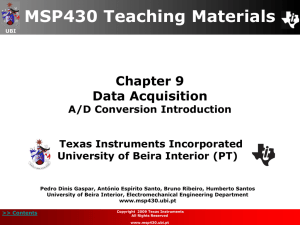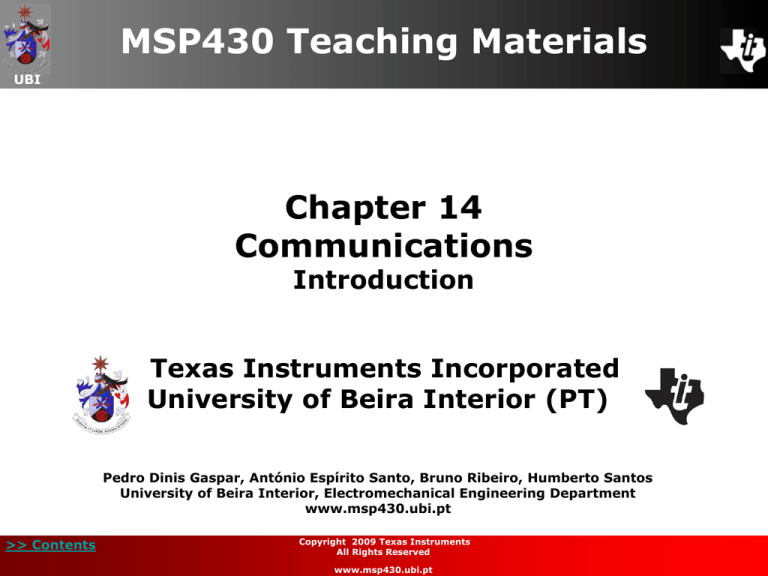
MSP430 Teaching Materials
UBI
Chapter 14
Communications
Introduction
Texas Instruments Incorporated
University of Beira Interior (PT)
Pedro Dinis Gaspar, António Espírito Santo, Bruno Ribeiro, Humberto Santos
University of Beira Interior, Electromechanical Engineering Department
www.msp430.ubi.pt
>> Contents
Copyright 2009 Texas Instruments
All Rights Reserved
www.msp430.ubi.pt
Contents
UBI
Introduction
Communications system model
Transmission mode
Serial communications
Synchronous and asynchronous serial communications
Peripheral Interface Serial (SPI) protocol
I2C (Inter-Integrated Circuit) protocol
MSP430 communications interfaces
Quiz
>> Contents
Copyright 2009 Texas Instruments
All Rights Reserved
www.msp430.ubi.pt
2
Introduction
UBI
An important feature of modern microprocessor based
systems is their communication capability, that is, their
ability to exchange information with other systems in
the surrounding environment;
At the low level, communications interfaces are used to
download a firmware update or to set up local
configurations (e.g. turn features on or off), amongst
other tasks;
At a higher level, communication interfaces are used to
exchange information in distributed applications.
>> Contents
Copyright 2009 Texas Instruments
All Rights Reserved
www.msp430.ubi.pt
3
Communications system model (1/2)
UBI
Digital communication devices:
Transmitter: Has the task of putting the information into
the appropriate format for subsequent transmission;
Receiver: Is responsible for collecting the message that
has been sent and extracting the original information;
Communication medium: The physical medium through
which the information flows and is commonly implemented
as:
• Twisted pair wire;
• Fibre optic cable;
• Radio frequency transmission.
>> Contents
Copyright 2009 Texas Instruments
All Rights Reserved
www.msp430.ubi.pt
4
Communications system model (2/2)
UBI
Devices participating in a digital communication system:
DTE: Data Terminal Equipment;
DCE: Data Communications Equipment.
Transmitter
Receiver
Transmission
medium
DTE
DCE
DCE
Receiver
>> Contents
DTE
Transmitter
Copyright 2009 Texas Instruments
All Rights Reserved
www.msp430.ubi.pt
5
Transmission mode (1/5)
UBI
Communications between digital devices can be divided
into two types :
Parallel communications;
Serial communications.
Parallel communications:
The physical transmission medium has independent signal
lines in numbers equal to the transmitted digital word bits;
The information transmitted at any given instant is the data
word formed by the logical levels on the various signal lines.
>> Contents
Copyright 2009 Texas Instruments
All Rights Reserved
www.msp430.ubi.pt
6
Transmission mode (2/5)
UBI
Parallel communications:
Example: Character ASCII “W” parallel transmission.
Wire 8
Wire 7
Wire 6
Wire 5
Wire 4
Wire 3
Wire 2
Wire 1
Bit 8=0 (odd parity)
Bit 7=1 (MSB)
Bit6 =0
Bit 5=1
Bit 4=0
Bit 3=1
Bit 2=1
Bit 1=1 (LSB)
Transmitter
Receiver
Info flow
Information
flow
>> Contents
Copyright 2009 Texas Instruments
All Rights Reserved
www.msp430.ubi.pt
7
Transmission mode (3/5)
UBI
Serial communications:
Physical transmission medium needs only one signal line;
The information transmitted is provided by the transmitter
as a sequence of bits, sent at the rate established between
the transmitter and the receiver;
Additional information is needed to enable the
synchronization between the receiver and transmitter:
• Start bit: Added to the beginning of the information
transmitted, so that the receiver can identify the
beginning of a new transmission;
• Stop bit(s): Added to the end of the information
transmitted to indicate that the data value is complete.
>> Contents
Copyright 2009 Texas Instruments
All Rights Reserved
www.msp430.ubi.pt
8
Transmission mode (4/5)
UBI
Serial communications:
Example: Character ASCII “W” serial transmission:
7 characters bits
(Hi)
Start
bit
Bit 1
Bit 2
Bit 3
Bit 4
Bit 5
Bit 6
Bit 7
Parity
bit
Stop
Stop
(low)
8 data bits
11 bit per character
>> Contents
Copyright 2009 Texas Instruments
All Rights Reserved
www.msp430.ubi.pt
9
Transmission mode (5/5)
UBI
Advantages and disadvantages of parallel and serial
communication:
Characteristic
Bus line
Sequence
Parallel
Serial
One line per bit
All
bits of one
simultaneously
One line
word
Sequence of bits
Transmission
rate
High
Low
Bus length
Short distances
Short and long distances
Cost
High
Low
Asynchronous transmission
Synchronisation between
needs start and stop bits
Critical
the different bits is Synchronous transmission
characteristics
demanding
needs some other
synchronisation
>> Contents
Copyright 2009 Texas Instruments
All Rights Reserved
www.msp430.ubi.pt
10
Serial communications (1/3)
UBI
The start bit identifies the beginning of a data transfer
and is generated by a high-to-low transition on the bus;
Following the start bit are the data bits. In this example,
the ASCII code for the text transfer uses seven data
bits;
The error-checking bit (parity bit) is sent after the data
bits;
To terminate the transmission, one or two stop bits are
issued;
Using seven data bits, the complete message can use
one or two stop bits. Using eight data bits, only one stop
bit is available for transmission.
>> Contents
Copyright 2009 Texas Instruments
All Rights Reserved
www.msp430.ubi.pt
11
Serial communications (2/3)
UBI
Parity bit:
Used to verify the integrity of information transmitted;
The bit is added by the transmitter and indicates whether
the total sum of the numbers "1" in the message data is odd
or even;
The transmissions can be configured for odd or even parity.
7 bit ASCII code
Bit
B
Q
3
z
>> Contents
1
2
3 4
5
6
7
0
1
1
0
1
0
1
1
0
0
0
0
0
1
1
1
0
0
1
1
1
1
0
1
0
0
0
1
Copyright 2009 Texas Instruments
All Rights Reserved
www.msp430.ubi.pt
Parity
bit odd
1
0
1
0
Parity
bit even
0
1
0
1
12
Serial communications (3/3)
UBI
Baud rate example:
The transmission of “W”:
• Character uses seven data bits;
• Four bits are used for control, making a total of 11 bits.
• This corresponds to 11 baud;
• If the characters are transmitted at a rate of 10
characters per second, the baud rate will be:
10x11 = 1100 baud/s.
>> Contents
Copyright 2009 Texas Instruments
All Rights Reserved
www.msp430.ubi.pt
13
UBI
Synchronous and asynchronous serial
communications (1/2)
Serial communications may be:
Asynchronous: where the transmission rate (baud rate) is
fixed by the transmitter and the receiver works at the same
baud rate, using the transmitted start bit to synchronize the
start of a new message;
Synchronous: where there is a separate synchronization
clock signal connected between the receiver and the
transmitter.
Synchronous communications:
Normally one unit assumes the role of master and one or
more of the other units take the role of slaves;
The clock signal generated by the master is used by the
slave units to transfer data in/out of the TX and RX
registers;
It is possible for a device to transmit and receive
simultaneously.
>> Contents
Copyright 2009 Texas Instruments
All Rights Reserved
www.msp430.ubi.pt
14
Synchronous and asynchronous serial
communications (2/2)
UBI
Asynchronous communications:
Characterised by the absence of any synchronization clock
signal between the units;
The transmission in this mode does not allow simultaneous
transmission and reception, that is, when one device
transmits the other devices just listen.
>> Contents
Copyright 2009 Texas Instruments
All Rights Reserved
www.msp430.ubi.pt
15
UBI
Serial Peripheral Interface (SPI) protocol
(1/2)
The Serial Peripheral Interface ( SPI) bus is a standard
form of synchronous serial communication;
Developed by Motorola;
Operates in full duplex mode;
Master/Slave relationship;
Communications are always
initiated by the master.
Low cost.
>> Contents
Copyright 2009 Texas Instruments
All Rights Reserved
www.msp430.ubi.pt
16
UBI
Peripheral Interface Serial (SPI) protocol
(2/2)
Supports only one master;
Can support more than a slave;
Short distance between devices, e.g. on a printed circuit
boards (PCBs);
Special attention needs to be observed to the polarity
and phase of the clock signal;
The master sends data on one edge of clock and reads
data on the other edge. Therefore, it can send/receive at
the same time.
>> Contents
Copyright 2009 Texas Instruments
All Rights Reserved
www.msp430.ubi.pt
17
I2C (Inter-Integrated Circuit) protocol (1/3)
UBI
Multi-master synchronous serial computer bus;
Invented by Philips Semiconductors;
Developed with the main objective of establishing links
between integrated circuits and to connect low-speed
peripherals;
Based on a two bi-directional open-drain lines pulled up
with resistors:
• SDA: Serial Data;
• SCL: Serial clock.
Typical voltages used are +5.0 V or +3.3 V, although
systems with other voltages are possible.
>> Contents
Copyright 2009 Texas Instruments
All Rights Reserved
www.msp430.ubi.pt
18
I2C (Inter-Integrated Circuit) protocol (2/3)
UBI
Communications is always initiated and completed by
the master, which is responsible for generating the clock
signal;
In more complex applications, I2C can operate in multimaster mode;
The slave selection by the master is made using the
seven-bit address of the target slave;
The master (in transmit mode) sends:
Start bit;
7-bit address of the slave it wishes to communicate with;
A single bit representing whether it wishes to write (0) to or
read (1) from the slave;
The target slave will acknowledge its address.
>> Contents
Copyright 2009 Texas Instruments
All Rights Reserved
www.msp430.ubi.pt
19
I2C (Inter-Integrated Circuit) protocol (3/3)
UBI
Example of an I2C communication system:
VDD
uC
(master)
>> Contents
SCL
SDA
SCL
SDA
DAC
(slave)
SCL
SDA
EEPROM
(slave)
SCL
SDA
ADC
(slave)
Copyright 2009 Texas Instruments
All Rights Reserved
www.msp430.ubi.pt
20
MSP430 communications interfaces (1/2)
UBI
Equipped with three serial communication interfaces:
USART (Universal Synchronous/Asynchronous
Receiver/Transmitter):
• UART mode;
• SPI mode;
• I2C (on ‘F15x/’F16x only).
USCI (Universal Serial Communication Interface):
• UART with Lin/IrDA support;
• SPI (Master/Slave, 3 and 4 wire modes);
• I2C (Master/Slave, up to 400 kHz).
USI (Universal Serial Interface):
• SPI (Master/Slave, 3 & 4 wire mode);
• I2C (Master/Slave, up to 400 kHz).
>> Contents
Copyright 2009 Texas Instruments
All Rights Reserved
www.msp430.ubi.pt
21
MSP430 communications interfaces (2/2)
UBI
Comparison between the communication modules:
USART
USCI
USI
UART:
- Only one modulator
- n/a
- n/a
- n/a
UART:
- Two modulators support
n/16 timings
- Auto baud rate detection
- IrDA encoder & decoder
- Simultaneous USCI_A and
USCI_B (2 channels)
SPI:
- Only one SPI available
- Master and Slave Modes
- 3 and 4 Wire Modes
SPI:
- Two SPI (one on each
USCI_A and USCI_B)
- Master and Slave Modes
- 3 and 4 Wire Modes
SPI:
- Only one SPI available
- Master and Slave Modes
I2C:
- Simplified interrupt usage
- Master and Slave Modes
- up to 400kbps
I2C:
- SW state machine needed
- Master and Slave Modes
I2C:
(on ‘15x/’16x only)
- Master and Slave Modes
- up to 400kbps
>> Contents
Copyright 2009 Texas Instruments
All Rights Reserved
www.msp430.ubi.pt
22
Quiz (1/6)
UBI
1. In the parallel communication transmission mode:
(a) The data is transferred more slowly;
(b) Each bit of the data has its own line;
(c) All of above;
(d) None of above.
2. In the serial communication transmission mode:
(a) The data bits arrive sequentially;
(b) The digital data is transferred faster;
(c) All of above;
(d) None of above.
>> Contents
Copyright 2009 Texas Instruments
All Rights Reserved
www.msp430.ubi.pt
23
Quiz (2/6)
UBI
3. The serial transmission mode is the most popular
digital data communications method because:
(a) Higher bit transfer rates are achieved;
(b) It is cheaper to implement than parallel transmission mode;
(c) All of above;
(d) None of above.
4. In asynchronous serial transmission communications,
the frame must include:
(a) Start and stop bits.
(b) Parity bit.
(c) All of above;
(d) None of above.
>> Contents
Copyright 2009 Texas Instruments
All Rights Reserved
www.msp430.ubi.pt
24
Quiz (3/6)
UBI
5. Even parity means that an additional bit is:
(a) Added to the data to make the sum of the “1” bits even;
(b) Subtracted from the data to make the sum of the “1” bits
even;
(c) All of above;
(d) None of above.
6. A USART is used:
(a) Only for asynchronous transmissions;
(b) Only for synchronous transmissions;
(c) In parallel transmission communications;
(d) In serial transmission communications.
>> Contents
Copyright 2009 Texas Instruments
All Rights Reserved
www.msp430.ubi.pt
25
Quiz (4/6)
UBI
7. Synchronous communication performed between two
USART requires:
(a) A common clock either in the transmitter or the receiver;
(b) No common clock;
(c) An independent clock in the transmitter;
(d) An independent clock in the receiver.
8. Asynchronous communication between two USARTs
requires:
(a) A common clock in the transmitter and the receiver;
(b) An independent clock in the transmitter and the receiver;
(c) A common clock in the transmitter or the receiver;
(d) An independent clock in the transmitter or the receiver.
>> Contents
Copyright 2009 Texas Instruments
All Rights Reserved
www.msp430.ubi.pt
26
Quiz (5/6)
UBI
9. I2C is a bus:
(a) Synchronous with a master and a slave where both can be
the transmitter or receiver;
(b) Where the master generates the clock;
(c) All of above;
(d) None of above.
>> Contents
Copyright 2009 Texas Instruments
All Rights Reserved
www.msp430.ubi.pt
27
Quiz (6/6)
UBI
Answers:
1. (b) Each bit of the data has its own line.
2. (a) The data bits arrive sequentially.
3. (c) All of above.
4. (c) All of above.
5. (a) Added to the data to make the sum of the “1” bits even.
6. (d) In serial transmission communications.
7. (a) A common clock either in the transmitter or the receiver.
8. (b) An independent clock in the transmitter and the receiver.
9. (d) None of above.
>> Contents
Copyright 2009 Texas Instruments
All Rights Reserved
www.msp430.ubi.pt
28

